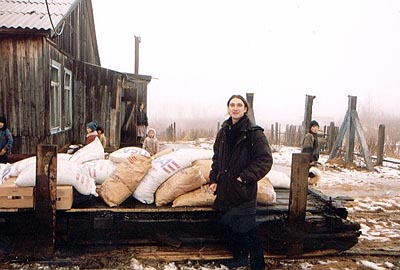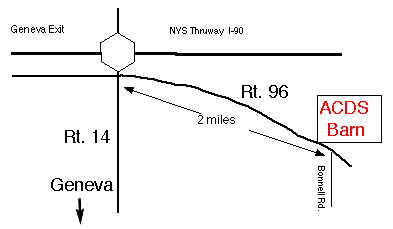Northeast Buckwheat Growers Newsletter
No. 11 June 2001
Edited by Thomas Bjorkman, Cornell NYSAES, Geneva NY
- Manisoba in 2000
- BF buckwheat
- 2000 harvest recap
- American buckwheat in Russia
- Crone Farms: networking in central PA
- 2001 Field Day
- Manitoba update
- Buckwheat bread book
Manisoba in 2000
A new variety of buckwheat called Manisoba was adopted by growers for The Birkett Mills in 2000. After many years of testing in Experiment Station trials and on commercial farms, it was found to be consistently superior to the previous variety, Manor.
The 2000 season turned out to be a bad one for introducing a new variety! A wet summer caused severe stand losses at planting and poor seed fill in the weeks before harvest. Throughout the region, buckwheat yields and test weights were miserable.
But it is not the fault of the new variety. In 2000 a side-by-side replicated trial of Manor and Manisoba, the new variety was still superior. Manisoba yielded 591 gross pounds per acre, vs. 573 for Manor. As bad as the year was, it would have been worse with Manor. Overall, Manisoba has better early growth and covers the ground better than Manor. It yields, on average, about 10% more by weight. The only known drawback, occasionally lower test weight, was painful in 2000.
Nevertheless, the adoption of an improved variety that has been thoroughly tested for the Northeast represents a significant advance for buckwheat production here.
BF Buckwheat
Les Shugar of W.G. Thompson & Sons in Ailsa Craig, Ontario, has developed a buckwheat variety called BF buckwheat. BF is a synthetic variety that is the progeny of Manor, Mancan and Manisoba, and has been earlier-maturing and shorter than its parents in Ontario trials. It was developed to better tolerate the summer heat experienced in parts of central* Canada and the Northeast US. Reduced lodging and use in shorter season situations are two benefits. He hopes to have it on the market in a year or two.
*that's Ontario and parts of Quebéc according to my friends in the Maritimes.-TB

2000 Harvest Recap
Frequent heavy rains in early July on already wet ground made planting buckwheat a challenge. Once in the ground, many seeds rotted or produced weak stands. These weak stands yielded from nothing to a few hundred lb/ac. Previous research in the Bjorkman lab has shown that the plant is drastically weakened if the germinating seed is waterlogged for just a few hours.
Even where a decent stand was obtained, the period of seed fill saw a return of cool, wet weather. As a result, seed fill was poor. There were enough seeds, but the small groat reduced both the yield and the test weight.
Things were bad all over North America. The Northern Plains had very cold conditions at emergence, and many plants lost leaves at the 3-4 leaf stage. Brian Sweeney of Agricore in Manitoba called it the worst harvest in 25 years. In the Pacific Northwest, frost just before maturity wiped out the harvest completely.
Our buckwheat helped get Russia through the winter
From the 2000 harvest, USDA purchased about 10,000 tons of buckwheat for food aid to Russia. Buckwheat is an important staple food there, but their agricultural production is in disarray. USDA's Commodity Credit Corporation buys buckwheat for distribution in Russia by private volunteer organizations, such as the Red Cross, Project Aid Siberia and Global Jewish Assistance. Michael Fay, the branch chief for Foreign Agriculture at USDA, anticipates similar demand coming up next year.
Russia normally produces about 600,000 tons of buckwheat every year; in 1998 that had dropped to 350,000 tons. The US contribution is pretty small compared to their need, but it went where it was most needed. Rose Paquette of Project Aid Siberia wrote from Novosibirsk that the buckwheat is really appreciated, from the big cities to the remote villages where they distribute the buckwheat and other food. 
The buckwheat we sent is about 20% of US annual production. Since the Northeast had a poor harvest and the Northwest was completely frosted out, the national supplies of buckwheat are very low. In anticipation of the food aid program continuing, buckwheat growers in the Northern Plains are trying to double their planted acres over last year, according to Juan Pedraza of Minn Dak Growers Ltd. Locally, Birkett Mills has raised the contract price back to $11.00 per hundredweight in anticipation of the greater demand.
Pictured above: buckwheat being delivered to a Siberian village by Project Aid Siberia.
Crone Farms network in central Pennsylvania
Stanley Crone of Danville, Montour Co., PA, has put together a group of growers who share in a single production contract and consolidate shipments for delivery to AgriCulver or Birkett Mills. His model could be followed in other places where shipping is a challenge for individual small growers. Mr. Crone raises about 400 acres of buckwheat himself, and the 5 or 6 other growers harvest an additional 400 acres. Everyone delivers their grain to the Crone farm where it is cleaned and dried. It is weighed when it goes on the truck. When several growers' production is combined on one truck, each grower is paid for his proportion of the load. Since the grain has been cleaned and dried first, the differences in dockage are thought to be small. With 15 years of experience growing a large acreage of buckwheat, Mr. Crone can provide good advice when a farmer new to buckwheat joins the group. This solid teamwork provides nice benefits for everyone involved.
In this part of Pennsylvania, where the two branches of the Susquehanna join, buckwheat is sown the first week of August, after the wheat is off. With such a late seeding, the yield potential is lower. This is reasonable for double-cropping situations. A yield of 20 bu/ac is the most to be expected. A big payoff comes in the spring when the ground is in perfect condition for no-till corn. The buckwheat especially helps suppress triazine resistant lambsquarters and pigweed. The buckwheat uses carryover fertilizer from the wheat, reducing production costs as well as nitrate-leaching risk going into winter.
Even when seeding August 1, the crop was essentially mature when the frost on Sept. 28, 2000 got the tops of the plants. Our buckwheat varieties are known to respond to the shortening days and cooler nights by hurrying maturation. That makes the grain mature at the same time as a July 4 seeding, however, the plants get only about 2 feet tall.
Beekeepers supply the farms with hundreds of hives at no cost. Apiarists in the area are looking for good sources of food for their bees during that time and are happy to find these abundant buckwheat fields.
For harvest, Mr. Crone direct cuts. He likes the new John Deere head with extra fingers on the auger for getting the stalks to move. With the relatively short stalks, dirt can be a problem. He has to persuade his colleagues to raise the cutter and to turn the air up as high as it needs to be. That echoes the thoughts of many experienced buckwheat harvesters--it is hard to have too much air.
2001 Field Day
 The location for the 2001 Northeast Buckwheat Field Day will be the same as in 2000. Grant Jordan of ACDS Research has offered their buckwheat trial site in Waterloo, near the Geneva Thruway exit. The date is Tuesday, August 28, and the event will run from 1:00 to 3:30 pm. Mark your calendars!
The location for the 2001 Northeast Buckwheat Field Day will be the same as in 2000. Grant Jordan of ACDS Research has offered their buckwheat trial site in Waterloo, near the Geneva Thruway exit. The date is Tuesday, August 28, and the event will run from 1:00 to 3:30 pm. Mark your calendars!
Manitoba update
The Manitoba Buckwheat Growers Association has successfully petitioned the provincial government to have a checkoff program to support research and development work. 74% of the growers voted in favor of the checkoff. With about 25,000 acres, the Manitoba group plants about the same amount at do growers in the Northeast.
- From "The Groat" Newsletter of the MBGA
Buckwheat bread book
Peter de Niverville has published a new book of buckwheat recipes called "Buckwheat Pete Bakes Pitas and Tea Biscuits." It is notoriously difficult to bake bread from pure buckwheat flour, but the author has a clever technique of using tapioca to bind the dough. As many of you know, people with gluten allergies or celiac disease cannot eat wheat and often crave a good bread. And buckwheat does taste good for all of us. The book is available at: http://www.buckwheatpete.com.
